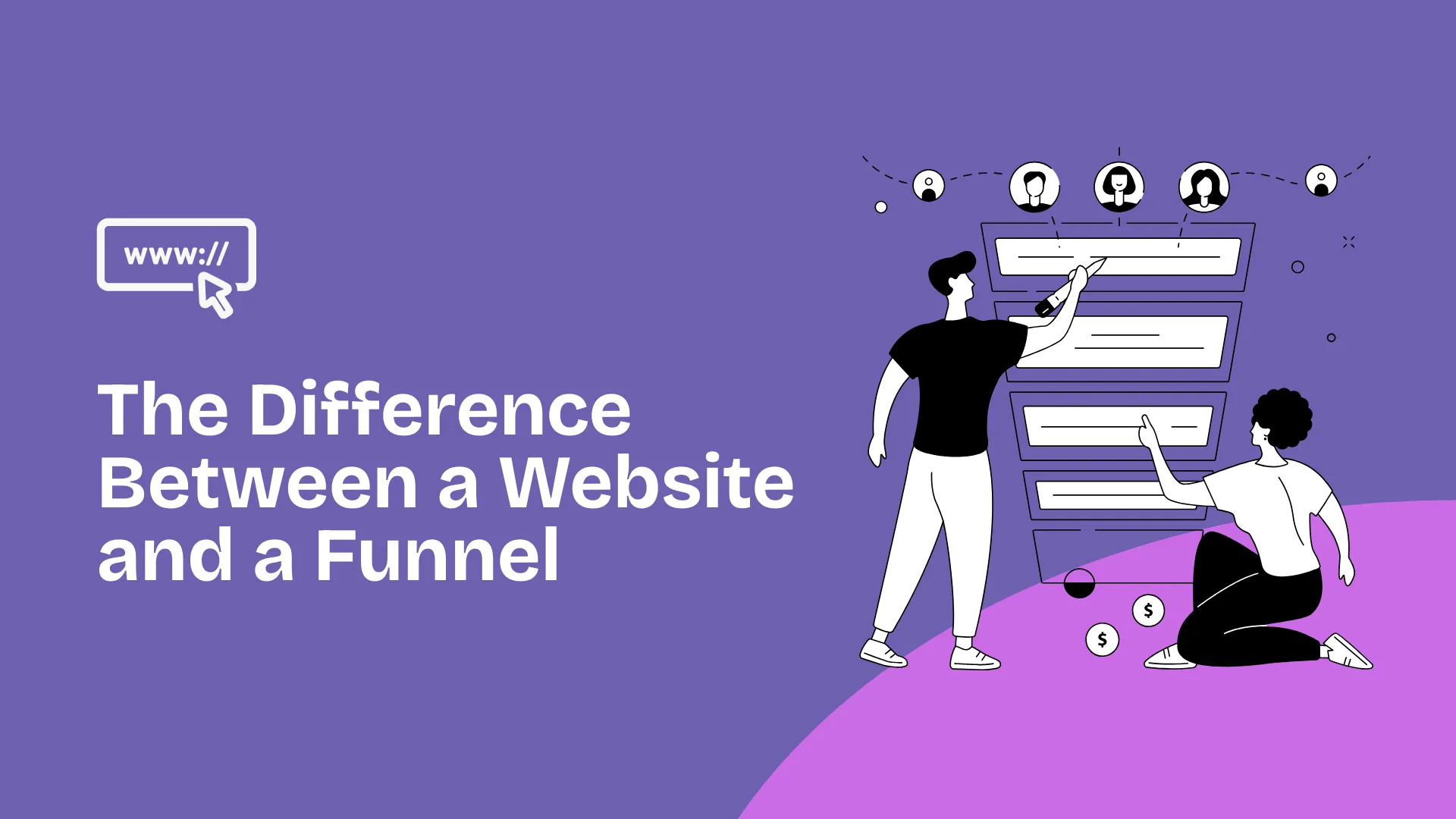If you’re setting up your business online, you’ll hear two things:
- “You need a website.”
- “Forget websites — build a funnel.”
Both sides are confident. But they’re usually selling you something.
Here’s what matters: a website and a funnel do completely different jobs. If you don’t understand the difference, you’ll either waste time building the wrong thing, or worse — spend money sending traffic to something that doesn’t convert.
A website gives visitors control. They can browse, compare, read, and decide on their own timeline. It works well when someone already knows who you are — maybe they found you on Google, got a referral, or saw your name somewhere and now they’re checking you out. They’re curious, but not ready to act. A good website gives them space to learn without pushing them too hard.
A funnel does the opposite. It takes control of the experience. It’s built to guide one person toward one outcome. You might be offering a free download, booking a call, or selling something directly — either way, the funnel removes all distractions and asks for a decision. Fast.
This is why the “website vs funnel” debate matters. If you’re running paid ads and sending cold traffic to a generic homepage, you’re burning cash. The person landing on your site doesn’t know what to click, where to start, or what matters. But if you’re trying to build long-term visibility and credibility through Google — and all you have is a three-step funnel — no one will ever find you.
You don’t need to pick one forever. Most businesses use both. The smart move is understanding what each one does best — and using them in the right context.
What Is a Website?
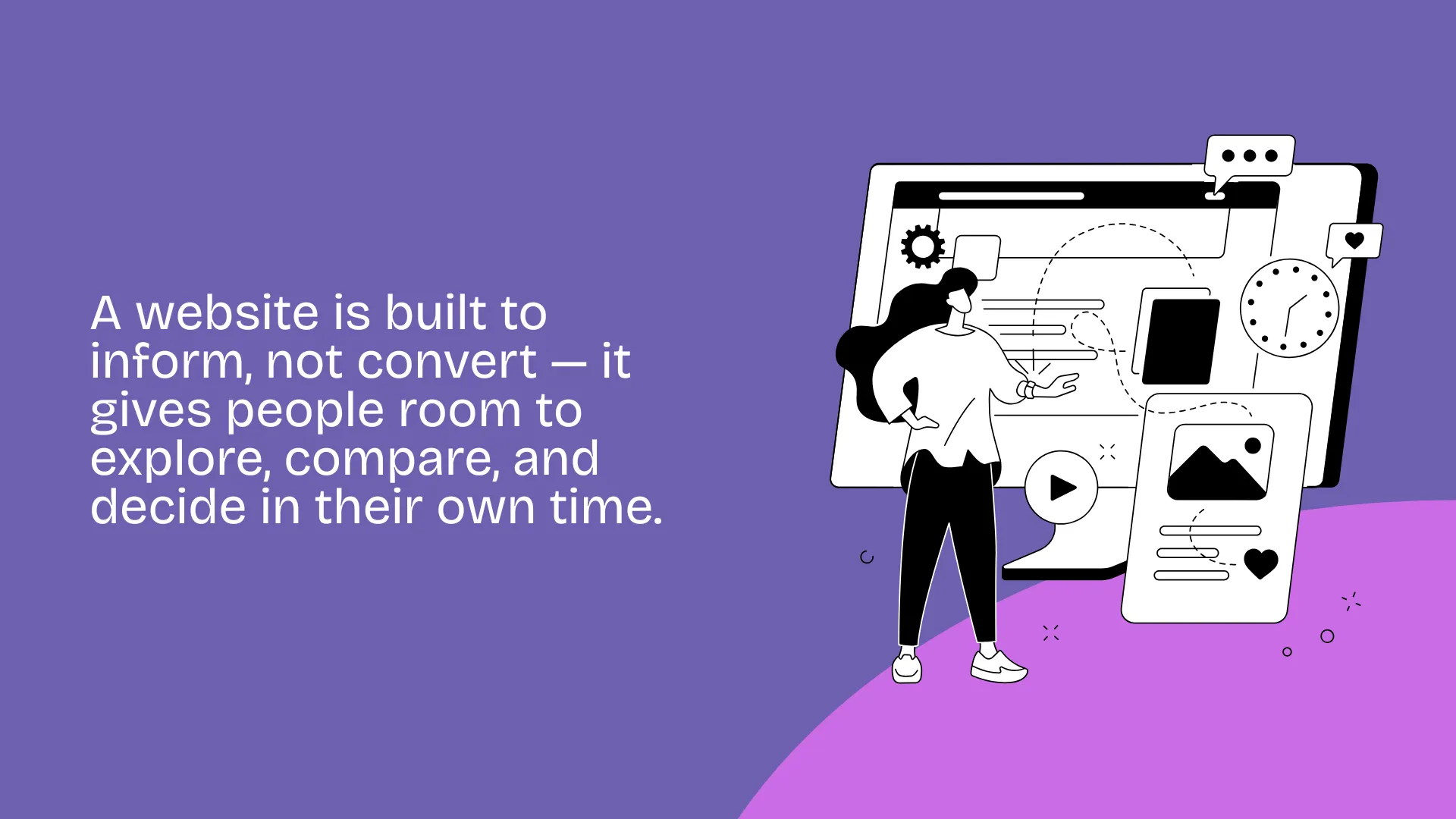
A website is your online base. It’s where people go when they want to learn more about you — not when they’re ready to take action straight away.
Here’s what a website actually does:
- It gives people options. They can browse your services, read your About page, check your contact info, or skim your blog. Nothing is forced.
- It works well for warm traffic. These are people who already know your name — maybe from a referral, a Google search, or social media.
- It’s built for research. Visitors use websites to compare you with other options, see if they trust you, and decide if you’re the right fit.
- It supports long-term visibility. A well-built website with SEO helps people find you months or years from now — without needing to run ads.
Most websites have:
- A homepage that introduces the business
- Service or product pages
- An About page
- A Contact page
- Possibly a blog or FAQ section
Websites are great for credibility. They show you’re real. But they’re not built to drive instant action — which is why they often don’t convert well if you send cold ad traffic to them.
You need a website if:
- You want people to find you on Google
- You offer multiple services
- You’re building long-term trust
- You want to look legitimate when someone checks you out
Just don’t expect a website to do a funnel’s job.
What Is a Funnel?
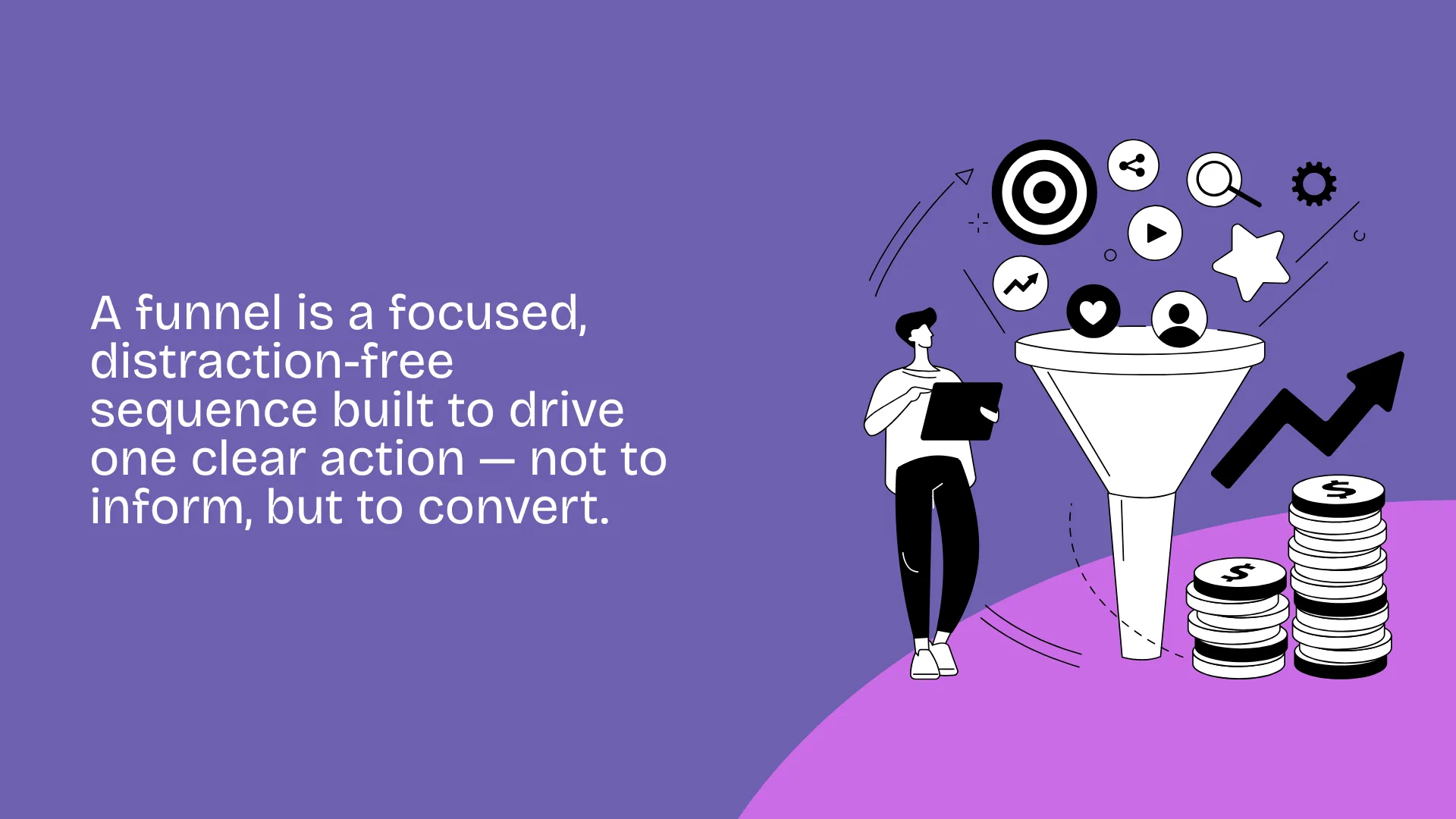
A funnel is built to do one thing — get someone to act.
Buy. Book. Sign up. That’s it.
There’s no homepage, no menu, no wandering around. Just a single path, step by step.
Here’s what a funnel actually does:
- It removes distractions. No links, no navigation bar, no exit points — just one page leading to the next.
- It pushes one clear offer. Whether it’s a freebie, a consultation, or a product, the funnel is built around that one action.
- It works best for cold or paid traffic. You’re sending people in with a specific message — the funnel is there to back it up and convert.
- It’s fast and focused. Unlike websites, funnels don’t try to explain everything. They lead with a hook and drive the next step.
Most funnels follow a structure like this:
- A landing page with a strong headline and clear CTA
- An optional explainer or video section
- A form or checkout page
- A thank you or upsell page after action is taken
Funnels are ideal when:
- You’re running ads and need results
- You’re offering one thing at a time
- You want to test offers quickly
- You need to track conversions closely
Funnels convert better because they’re not built to explain — they’re built to close.
Website vs Funnel: Side-by-Side Comparison
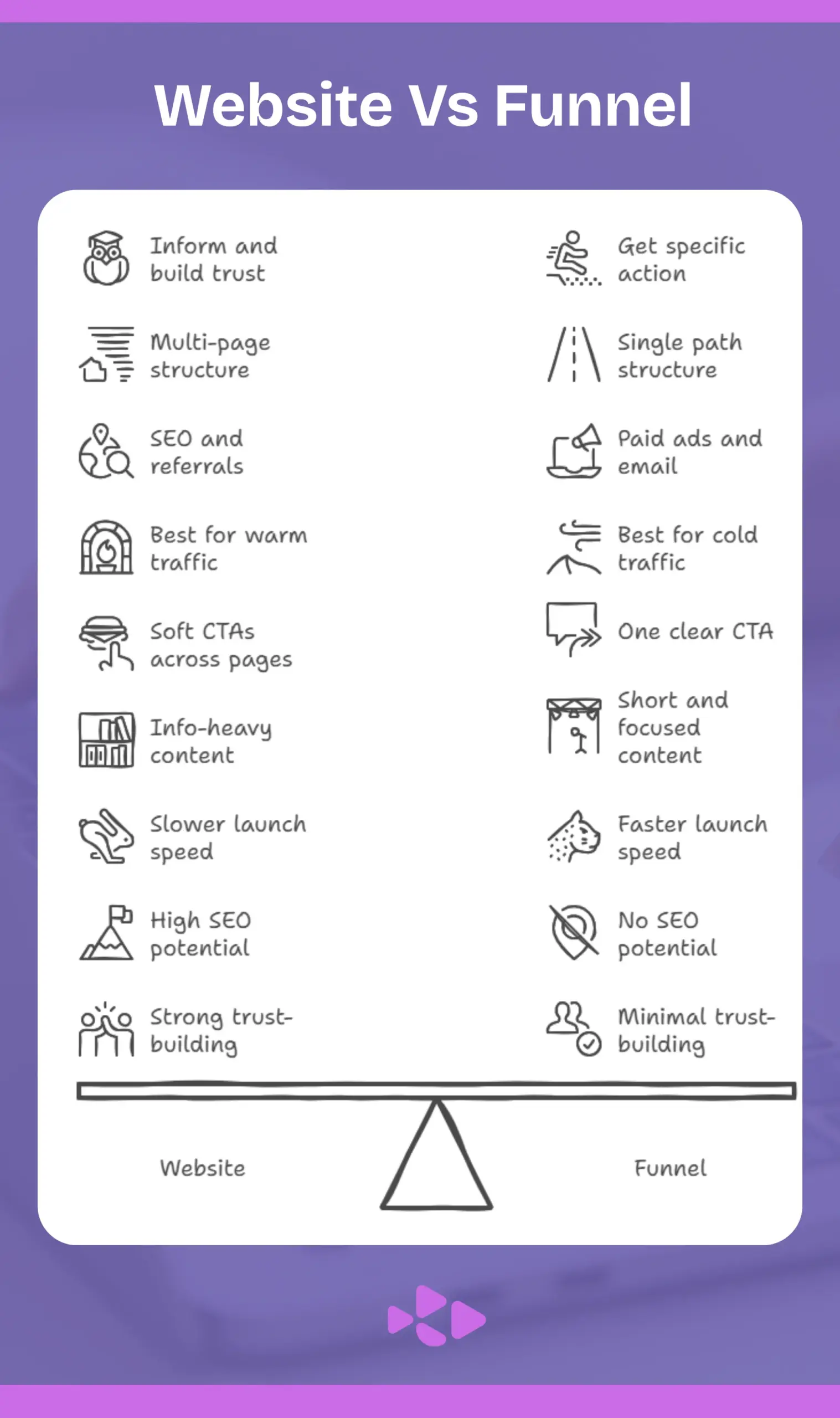
A lot of people get stuck trying to choose between a website and a funnel. Seeing the difference side by side makes it easier.
Here’s how they actually compare:
| Feature | Website | Funnel |
|---|---|---|
| Main goal | Inform, build trust, let people explore | Get a specific action (buy, book, sign up) |
| Structure | Multi-page, open navigation | Single path, one step after the other |
| Traffic source | SEO, referrals, direct search | Paid ads, email marketing, social campaigns |
| Best for | Warm traffic, research-driven visitors | Cold traffic, fast decisions |
| Conversion style | Soft CTAs across pages (“Learn more”, “Contact us”) | One clear CTA (“Buy now”, “Book a call”) |
| Content depth | Covers multiple services, info-heavy | Short, sharp, focused on one offer |
| Speed to launch | Slower — more pages, more content | Faster — fewer pages, faster testing |
| SEO potential | High — content can rank in search | None — funnels don’t rank on Google |
| Trust-building | Strong — shows credibility and depth | Minimal — relies on urgency and clarity |
| Use case example | A local business with multiple services | A Facebook ad offering a limited-time deal |
If you’re trying to build trust, go with a website.
If you’re trying to generate leads or sales quickly, use a funnel.
Most businesses eventually use both — they just don’t do the same job.
When Should You Use a Website?
Use a website when people need time to decide. That’s the simplest way to put it.
Websites work best when someone’s doing research, comparing options, or just trying to get a feel for who you are. They’re not in a rush. They want to understand what you do, how it works, and whether they can trust you. A good website gives them the space to do that.
Here’s when a website makes sense:
- You’re selling services, not products: Let’s say you’re a consultant, a tradie, a designer, or an NDIS provider. People don’t just hit “buy.” They want to know who they’re dealing with. A website helps them explore — your services, experience, pricing, testimonials, and contact options.
- You want to rank on Google: Funnels don’t show up in search. A website built with proper SEO can bring in traffic every week without ads. People searching for “podiatrist near me” or “SEO Melbourne” aren’t going to land on a funnel. They’ll land on a proper website.
- Your offer isn’t simple: If your business does multiple things — like design, development, and branding — or offers services for different types of clients, a funnel would be too limited. You need a website with pages for each service so people can find what’s relevant to them.
- You care about long-term presence: A website becomes your digital footprint. It’s what people will find when they Google your name. It shows you’re real. You don’t need to be actively running a campaign — your website keeps working in the background.
- You want to educate before you sell.Some customers aren’t ready to act. They just want information. A blog, FAQ page, or case study section on your website can warm people up before they ever click a button.
Related: How much does a website cost in Australia?
When Should You Use a Funnel?
Use a funnel when you want a result — now. Funnels are built for action, not browsing.
They don’t explain everything about your business. They don’t ask people to explore or learn more. They push one thing. One message, one offer, one button. And when you use them properly, they convert better than any website ever could.
Here’s when a funnel makes sense:
- You’re running paid ads: If you’re paying for traffic — Facebook ads, Google Ads, Instagram, whatever — don’t send people to your homepage. It’s a waste. You’ve got one shot to grab attention and guide a cold lead toward something useful. A funnel gives you that path: offer → decision → result. No fluff.
- You’re offering one clear thing: Let’s say you’re promoting a lead magnet, a free consultation, a discount, or a time-sensitive product. A website would bury that under menus and other services. A funnel puts it front and centre, no distractions. That’s how you turn clicks into bookings, downloads, or sales.
- You’re testing or launching something new: Funnels are quick to build. You don’t need 10 pages. You just need a landing page and a thank-you page. If it works, scale it. If it doesn’t, test a new angle. Funnels make it easy to validate offers before you invest in full-scale builds.
- You want clean conversion tracking: Funnels are linear. Step 1 leads to Step 2, and that’s it. You can measure everything: views, clicks, drop-offs, conversions. It’s simple math. That makes funnels perfect for campaign testing, optimisation, and scaling fast.
- You’re selling through email or direct messages: If you’re driving traffic from your email list, LinkedIn DMs, or Instagram bio, you don’t want to send people to a full site. You want them landing on something specific — a workshop, a download, a limited-time offer. That’s funnel territory.
Can You Use Both?
Yes — and you probably should.
Websites and funnels do different jobs. The smartest businesses don’t choose between them — they use both. Not at the same time, and not for the same audience. But side by side, each one supports the other.
Here’s how that looks in practice:
- Your website builds credibility: Someone sees your name, looks you up, and finds a real business — with a proper domain, a solid About page, service breakdowns, testimonials, and maybe some case studies or blog posts. That builds trust. It gives them reasons to believe you know what you’re doing.
- Your funnel drives conversion: While your website is working in the background (ranking in Google, getting referrals, showing legitimacy), your funnel is out there running the campaign. It’s doing the work of turning cold traffic into leads, bookings, or buyers. It’s where your ads point. It’s where your email subscribers go. It’s the action side of the engine.
You’re not sending everyone to the same place. Here’s the split:
- Someone searching you on Google? They hit your website.
- Someone clicking an Instagram ad for a discount? They hit your funnel.
- Someone reading your blog? Website.
- Someone opening your “Book now” email? Funnel.
If you try to make one do the job of the other, things fall apart. A funnel that tries to act like a website becomes confusing — too many links, too much text, no clear path. A website that tries to act like a funnel feels pushy and out of place.
Used properly, here’s what happens:
- You look credible to warm leads
- You convert cold leads efficiently
- You capture short-term wins while building long-term assets
- You avoid wasting ad spend
- You stop losing leads who aren’t ready yet
Think of your website as your base — where people learn about you.
Think of your funnel as your campaign — where people take action.
Don’t try to turn one into the other. Use each for what it’s built to do.
Common Mistakes to Avoid
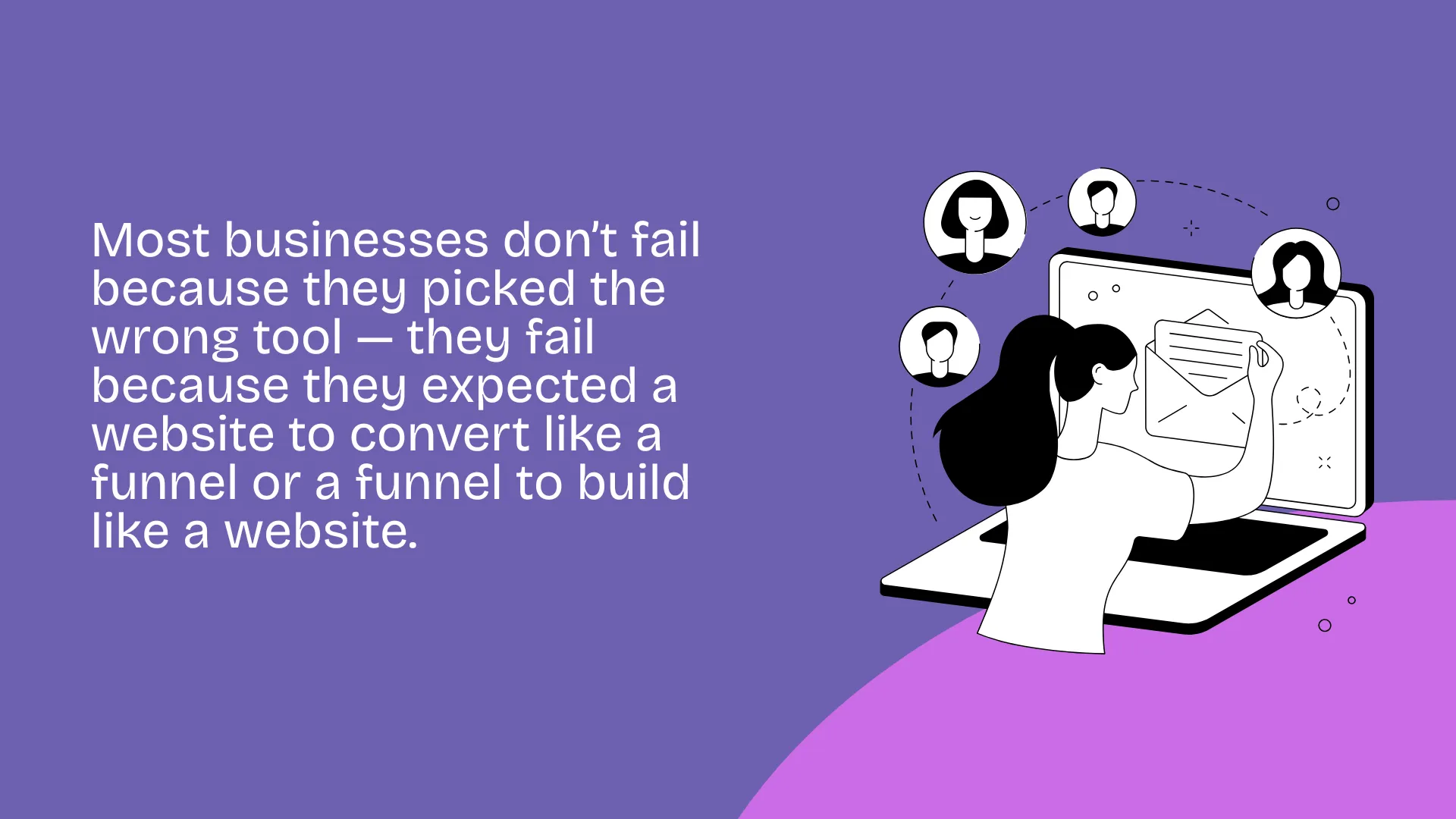
Choosing between a website and a funnel isn’t hard. What trips people up is using them the wrong way, at the wrong time, or expecting results they’re not built to deliver.
Here’s a complete breakdown of the most common mistakes — and how to avoid burning traffic, budget, and credibility.
1. Sending ad traffic to your homepage
You run an ad, someone clicks, and they land on your homepage. There’s no headline, no offer, just a menu bar and some vague copy about your business. The user has to figure out where to click next — and most won’t. They bounce.
Why it fails:
- The homepage is built for browsing, not converting
- There’s no direct message-match between the ad and the page
- You’re giving cold leads too many options and no direction
What to do instead:
- Build a landing page with a clear headline, benefit, and single CTA
- Remove all distractions — no menus, no links, no fluff
- Align the page with the promise in the ad
2. Relying on funnels for organic search
Funnels don’t rank. They aren’t designed to. They’re short, they’re offer-driven, and they often lack the content depth search engines look for. If you only build funnels, your long-term visibility will suffer.
Why it fails:
- Funnels have little to no content targeting search intent
- There’s no internal linking structure
- You miss out on passive traffic from people searching for what you do
What to do instead:
- Build a proper website with SEO-friendly pages
- Write for real search terms (e.g. “NDIS speech therapy in Sydney,” “best dentist in Melbourne”)
- Use content to build trust over time — then lead people into funnels once they’re warm
3. Trying to explain everything in a funnel
A funnel isn’t a pitch deck. It’s not supposed to explain your entire business. When you load a landing page with paragraphs of text, multiple services, or long menus — you kill the conversion.
Why it fails:
- Funnels are meant to guide fast action, not answer every question
- Too much information overwhelms cold leads
- You end up blending funnel and website, and neither works
What to do instead:
- Use the funnel for one offer, one audience, one CTA
- Keep it short, skimmable, and direct
- If someone needs more info, send them to your site first — not into a sales flow
4. Building a beautiful website with no clear action
Websites are often overdesigned and underperforming. Clean layout, nice images, modern fonts — and no leads. Why? Because the site doesn’t guide the user toward anything. No clear next step, no strong CTA, just passive content.
Why it fails:
- Visitors don’t know what to do next
- CTAs are buried, vague, or missing altogether
- The content informs, but doesn’t convert
What to do instead:
- Add clear CTAs to every page — “Book now,” “Download guide,” “Enquire today”
- Make it easy to take the next step without thinking
- Use button-based CTAs, not just contact forms
5. Using one tool for everything
The biggest mistake is expecting one tool to do both jobs. A funnel won’t build your brand or help you rank in Google. A website won’t convert cold traffic from a Facebook ad. If you try to use either one outside of its purpose, you’ll keep wondering why the results aren’t there.
Why it fails:
- Funnels lack depth and long-term reach
- Websites lack urgency and focus
- You end up with either low traffic or low conversion — sometimes both
What to do instead:
- Treat your website like a base — it builds trust, ranks, and informs
- Treat your funnel like a campaign — it grabs attention and converts fast
- Build each around a single job, and let them complement each other
Final Thoughts
You don’t need both a website and a funnel right away. But you do need to know which one fits your current stage of business.
If you’ve got nothing online yet and you’re trying to get traction quickly, start with a funnel. It’s faster to build, cheaper to launch, and designed to generate results. You only need one clear offer and a way to collect leads or bookings. Whether you’re running ads or promoting something directly, a funnel gives you a straight path from attention to action.
If people are already searching for your service — like “NDIS physiotherapist near me” or “electrician in Darwin” — a funnel won’t help. You need a proper website that shows up in search, builds trust, and gives visitors room to explore. A good website gives them everything they need to understand what you offer and why they should contact you.
If you’re running paid ads or sending cold emails, always send that traffic to a funnel. It’s built to convert strangers into leads, not to educate or explain everything about your business. A homepage with ten options is a guaranteed way to lose someone who clicked in with one specific goal.
But if your strategy is long-term — if you want to show up in search, look legitimate, and build authority — start with a website. Then layer funnels into the parts of your business that need performance: lead magnets, promotions, or high-converting offers.
There’s no one-size-fits-all. Funnels are for control. Websites are for context. Pick the one that fits your traffic source, your offer, and how people actually find you.
Use each one for what it’s built to do. That’s how you stop guessing — and start seeing results that make sense.
